
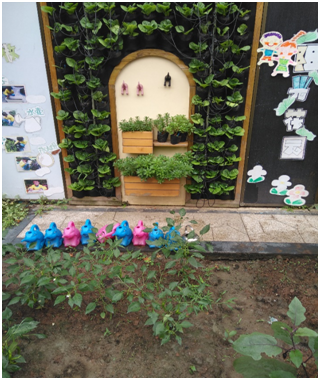
Gardening is great fun!! Beautifully tenderd plants adorn the kindergarten entrance! Small watering cans used by the children to ensure that plants get enough water!
Suggested resources
Bulbs herbs seed trays, planters, plant stickers/babels planting/flower pots wide range of seeds, bulbs plants (possibly donated from a local gardening centre!) gardening tools such as forks, spades, rakes water spray watering cans, lawn mower soil, compost, grow bags, garden furniture counter, till, money, phone gardening catalogues, local gardening brochure offers, fiction and non fiction books for reference purposes.
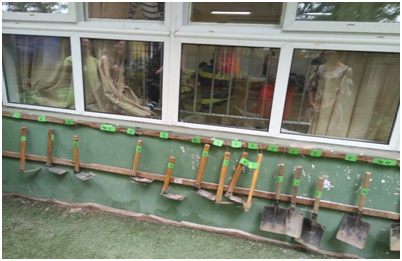
Garden tools safely stored after use by children from California Sunshine Kindergarten
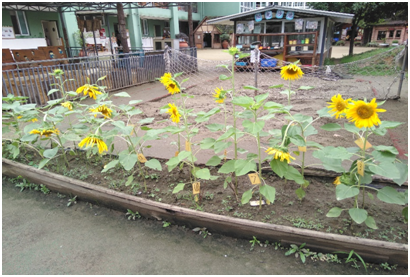
Sunflower plants from each class from the sixteen classes!
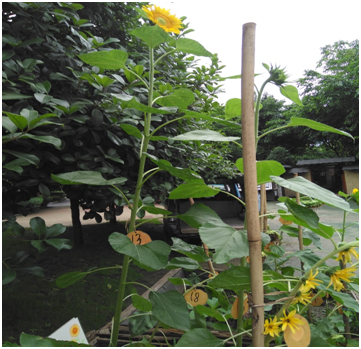
The tallest, winning sunflower!
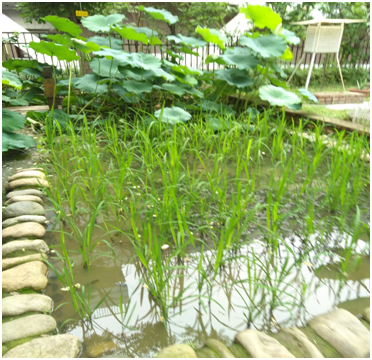
Rice crops are grown in ‘Sunshine kindergarten’, linked to the local history and the staple diet, rice which enables the children to explore the food chain


Amazing ‘Awe and Wonder’ Children plant black and green China tea, discuss similarities and differences. Planting activities meaningfully progresses to harvesting and making tea from the leaves! Children subsequently make tea for their parents at home with mothers moved to tears!
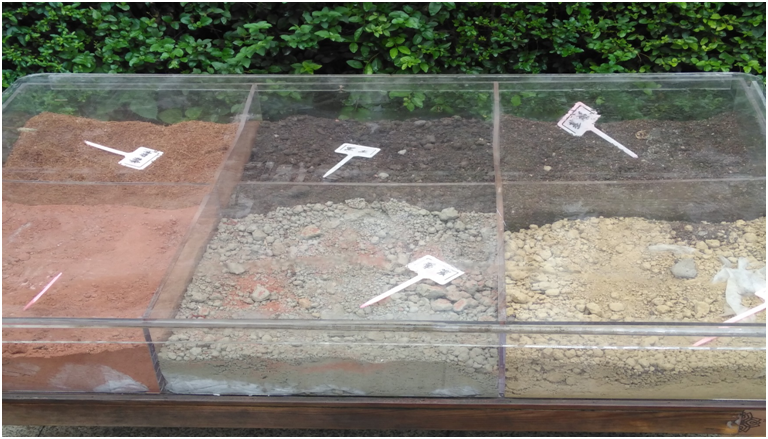
Children explore different types of soil and identify the ones suitable for planting
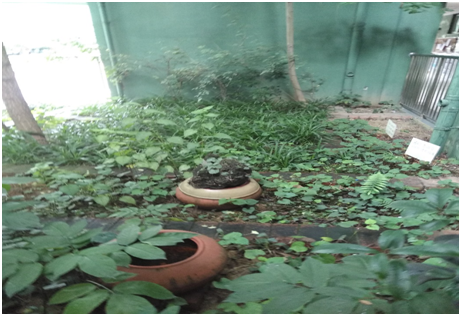
- More planting activities enables children to develop healthy lifestyles, be creative and self-sufficient!
- Examples of different spices that children from No 26 Kindergarten planted which is meticulously tendered to by the children. Evidently, it is high profile and taken very seriously which develops children’s confidence, independence and responsibility.
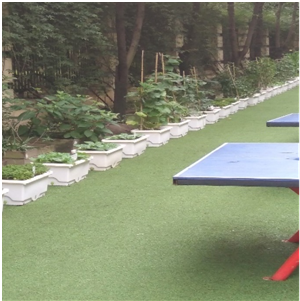
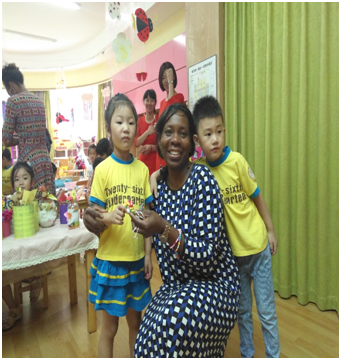
A cherished and memorable moment!
A very grateful Clementina happily receives lovely scented bags the children made from freshly harvested leaves from the garden!
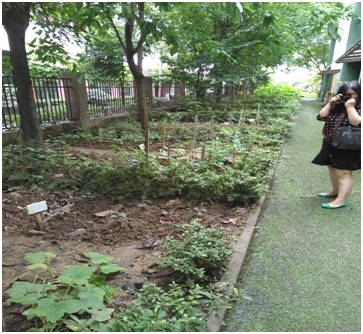
More herb planting from another nursery in Chengdu, China. Obviously, children spend a lot of time outdoors!
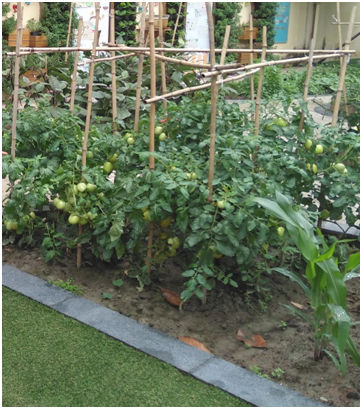
Healthy Fruit trees from No 26 Kindergarten, Chengdu
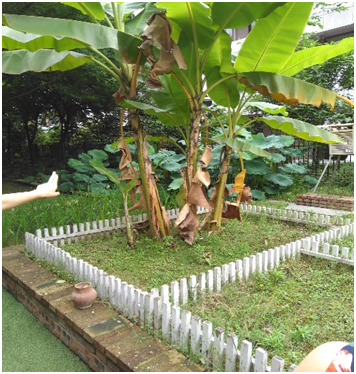
Even a banana plant receives a lot of care!
Project 1
Planting Sunflowers, Tea plants, Rice seeds Challenge:
- Which group has the tallest sunflower?
- How do you look after your sunflower?
- How long do you think it will take to start growing?
- What tools will you need and why?
- Could you identify the herb used in cooking activities?
- Could you make a picture guidebook on planting sunflowers?
- Could you write an instruction booklet on ‘How to plant a sunflower?
- Could you identify the spices used in cooking?
- What is your favourite spice?

You will need:
- Seeds, planting tools, spade, shovel, garden fork, gloves, compost, Picture symbols to represent numbers, children’s group name, measuring tape, paper, clipboard writing materials, non-fiction books on instructions for growing seed flowers or printed instructions from the internet
Suggested Activities
- Nature watch, look for worms and mini beasts and other insects.
- Talk about different tools, what they are used for and model how they are used, how they must be positioned
- Talk about different sizes of spades.
- Discussions about safety, safe outdoor/gardening kit such as gloves, helmet boots, safe use of tools, safe storage, safety rules, ‘dos and don’ts’
- Talk about weather features. Which weather pictures are perfect for planting?
- Model ‘planning vocabulary’ such as messy, soggy, digging, muddy.
- Excellent links to writing as activities provide ample opportunities for writing through pictures, discussions and storyboard to simply record all they have activities undertaken. This allows children to have excellent recall and sequencing skills.
- Children could also write their own instructions for planting sunflower seeds and helpful planting tips based on their planting experience!
Progression ideas

- Books on planting, mini beasts and insect characters such as ‘The Very hungry Caterpillar’ learn about digging, planting, looking ate plants in different seasons, threat to plant growth such as weed, snails, caterpillar, using technology such as magnifiers to undertake close observation, monitor, discuss similarities and differences stages of growth, explore reasons for poor/excellent plant growth and suggest ways to improve/solve problems
- Cross curricular links to expressive arts and design to link to observational drawings of the stages of growth from sunflower seeds to plants, labelled drawings of parts of a plant
- Links to sensorial experiences (children could make sensory boxes) to identify and explore the smell of herbs such as rosemary, thyme which are subsequently used in making pizza. Lavender could be used to make scented bags. This could be extended to writing different recipes or instructions including a ‘vegetarian recipe’
- Extend to fruit and vegetable planting activities
- Make fruit juices/salad from fresh produce
- Link to discussions on healthy eating and benefits of healthy lifestyles to encourage children on making healthy choices
- Children cook harvest vegetables and make different vegetable soups, sauces or jam such as strawberry jam
- Some of the soup, sauces could be part of parent workshop refreshments or sold to raise funds at school fair (depending on how bountiful your harvest is!)
- Make meaningful links to phonics awareness by undertaking vegetable printing with vegetables with the same initial sounds/letters: celery, carrots, cucumber, orange, lemon, lettuce.
- Guide children in writing vegetable riddles
- Opportunities to identify similarities and differences in patterns made by different vegetable slices
- Make an individual/group vegetable pattern with a title and short information fact file on the process
- Sort leaves according to size shape, compare properties, discuss and record findings. Adults could provide/model suggested words to support this if required
- Children to play games to spot a vegetable pattern print
- Provide opportunities for children to dress up in vegetable costumes such as carrot, cucumber, tomatoes, sweetcorn
- Meaningful links to problem solving: Are there enough watering cans, wellington boots for the children present in nursery today
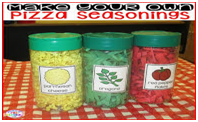
Promotion of independence
- Set up a rota for weekly helpers
- Some children could be part of an ‘Environment Task Force’ through watering the plants daily, handing out gardening equipment such as aprons and watering can. These opportunities allow children to make a positive contribution and develops their strong sense of responsibility and belonging to the school community

Helpful tips
- Meaningful links to understanding of the world through making tea, exploring local history, nutrition, historical lifestyles; occupation
- Tropical foods, food grown locally and why, linked to seasons
- Opportunities for parental involvement through contribution of seeds, preparation of gardening plot, fencing
Use of technology

- Children could use magnifiers for close observation followed by discussions of their findings
- Children could take pictures using a digital camera or iPad in order to record stages of growth, cycle of plant growth, changes in leaves features during different seasons with possible links to concept of time
- They could make meaningful comparisons with their predictions on how long it will take for the plant to flower or the outcome of their scientific background research before they commenced on their planting activity
- The predictions could be individual to different groups to facilitate meaningful discussions and outcome of their first hand observations
Ideas to explore:
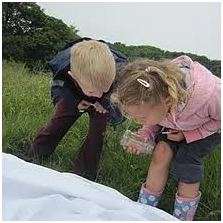
-
- Which seeds are related to children’s cultural heritage that could be planted?
- Think of seeds, plants or herbs that are related to the local environment that children would recognise to facilitate meaningful learning
- Choose a seed that children could harvest and use in cooking activities in order to make learning fun and exciting
- ‘Mini beast hunt’ to look for and collect mini beasts to closely observe with magnifiers and subsequent note taking
- Outdoor experiences could be linked around current themes such as mini beast, insect laboratory, story of the week such as identifying story characters by using a compass or ‘Walkie Talkie’ This could also be linked to exploration of positional language with meaningful links to a hand drawn map of the outdoor play area
- Provide plenty of opportunities for close observations, live commentary and of course incidental note taking!
- Allocate or provide children with choice of live presentation (as Science/Health/Nutrition correspondent or TV Presenters/Reporters) to capture/record planting progress over time, including the key moments of success!

Progression:
- Different herbs planted by the children.
Suggested ideas:
- Comparison of different herbs, smells textures, use such as herbs used for spices compared to lavender used to freshen the air and discussions of observations
- Children could draw the different leaves, plants and compare


Incredible amount of Hard work by the amazing and enthusiastic Green Fingers!

Things to think about
- What changes will you need to make to allow children to spend more purposeful learning time outdoors?
- Increase staff ratio’s to keep children safe?
- Ensuring children’s safety outdoors through routine use of sunhats, sun protection cream
- Make hygiene routines, such as regular washing of hands after gardening activities and handling insects and worms
- Remodel outdoor area to make more effective use of space?
- Resurface the grass area to provide a safe surface
- Provide a covered area to ensure continuous access?
- Provide children with outdoor clothing so they could play outside in all weathers?
- Improve the quality of outdoor provision to make it more vibrant?
- Extend the range of excellent quality resources?
- Review your curriculum?
- Plan outdoor activities
Working


